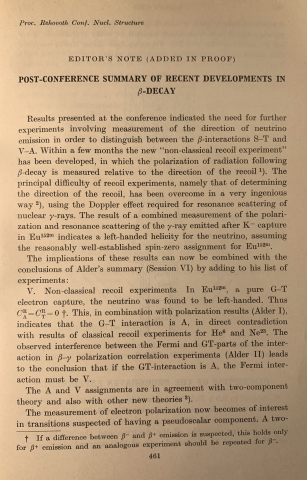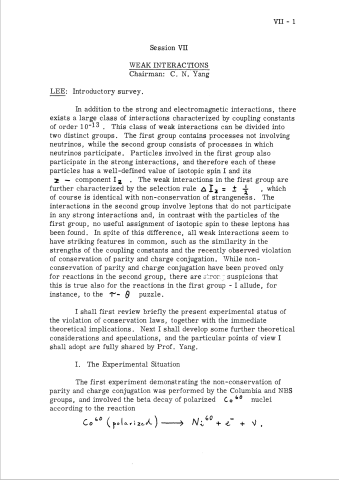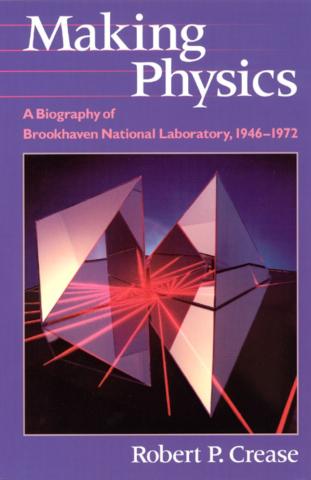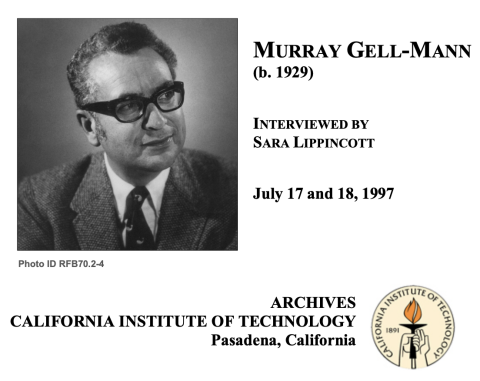My reasons for posting CU-173, the Wu-Schwarzchild report, as a public download
Brookhaven scientist Brice Rustad's untimely death in 1965 at age 43
POST-CONFERENCE SUMMARY OF RECENT DEVELOPMENTS IN BETA-DECAY

Lipkin's Editor's Note added in proof describes the yet-unpublished Brookhaven experiment on helicity of neutrinos.
Results presented at the conference indicated the need for further experiments involving measurement of the direction of neutrino emission in order to distinguish between the ß-interactions S–T and V–A. Within a few months the new "non-classical recoil experiment" has been developed, in which the polarization of radiation following ß-decay is measured relative to the direction of the recoil. The principal difficulty of recoil experiments, namely that of determining the direction of the recoil, has been overcome in a very ingenious way, using the Doppler effect required for resonance scattering of nuclear γ-rays. The result of a cominbined measurement of the polarization and resonance scattering of the γ-ray emitted after K– capture in Eu152m indicates a left-handed helicity for the neutrino, assuming the reasonably well-established spin-zero assignment for Eu152m.
The implications of these results can now be combined with the conclusions of Adler's summary (Session VI) by adding to his list of experiments: V. Non-classical recoil experiments.
This in combination with the polarization results (Alder I), indicates that the G-T interaction is A, in direct contradiction with results of classical recoil experiments for He6 and Ne19. The observed interference between the Fermi and GT-parts of the interaction in ß-γ polarization correlation experiments (Alder II) leads to the consulsion that if the FT-interaction is A, the Fermi interaction must be V.
The A and V assignments are in agreement with two-component theory and also with other new theories. [Sudarshan-Marshak and Feynman-Gell-Man are cited.]
Brice Rustad remained at Brookhaven before and after the experiment reversal
THE HALF-LIFE OF THE FREE NEUTRON
Rustad's posthumous final publication.
t t Formerly at Columbia University at BrookhavenNational Laboratory, now deceased.
The experimenters and technicians associated with this work express their sorrow at the untimely death of Brice Rustad and offer their condolences to his wife, Mrs. Mary Rustad.
Weak Interactions

Wu continued to favorably cite RR three months after her parity experiment. I am uncertain if her first reference to He6 (in relation to the Coulomb part) is about RR.
15-19 April 1957, Rochester, NY, United States (C57-04-15)
-
7th conference in the ICHEP series and
-
7th conference in the Rochester series
T.D. LEE:
We next turn to the Universal Fermi Interaction, which is an attempt to gain a more unified understanding of certain of the weak interactions. We draw the famous triangle representing the interactions of interest:
Beta decay information tells us that the interaction between ( ^p-i v\ ) and ( £ V ) is scalar and tensor, while the two-component neutrino theory plus the law of conservation of leptons implies that the coupling between ( V ) and ( /^y V ) is vector. This means that the Universal Fermi Interaction cannot be realized in the way we have expressed it. If all these coupling types turn out to be experimentally correct, we prefer to think that the similarity in coupling constants cannot be accounted for in terms of such a limited scheme. Rather it is a universal feature of all weak interactions, and not just those involving leptons. Nevertheless, at this moment it is very desirable to recheck even the old beta interactions to see whether the coupling is really scalar, a point to which we shall return later….
C.S. WU :
First, we may place an upper limit on the contribution from the Z-dependent Coulomb part, using the data supplied by the e-ν angular correlation in the decay of He6. Since Z = 28, α = 1/137 , and the He6 data indicates that the remaining factor is less than 2 /√3, the Z-dependent term is less than 0.23. Therefore most of the asymmetry is provided by the first term. But such a term exists only if neither charge conjugation nor parity are conserved, so the experiment already demonstrates the noninvariance of C and P.
The evidence on the relative strengths of scalar and vector components in the Fermi interaction is no longer so convincing as we previously had thought, because we don f t know if time reversal invariance holds true. The old methods used beta-neutrino angular correlations to determine the nature of the interactions. For example He6, which decays through a pure G. T. interaction, was used to show that this interaction is mostly tensor. Ne19 was used to investigate the Fermi interaction, but since here a mixture of Fermi and G . T . interactions is involved, this method turned out to be not very sensitive. The decay of A35 would furnish a much more sensitive test, because here I IMgr M p j 1 ^ l/atf Knowledge about the exact nature of the Fermi interaction, i . e . the relative strength of C and C v , becomes essential when we wish to select the best experimental method of testing time reversal invariance.
Nowadays we no longer need to use the beta-neutrino angular correlation method, which is difficult and insensitive. As Prof. Lee has pointed out, the longitudinal polarization of electrons from scalar, pseudo-scalar, and tensor interactions is different from the longitudinal polarization of electrons coming out of vector and axial vector interactions. Therefore it would be most interesting to investigate the longitudinal polarization of electrons coming from pure Fermi decays, i . e . 0 } 0 transitions, of which there are many.
Making Physics: A Biography of Brookhaven National Laboratory, 1946-1972

The author appears to be confused about Wu's comments at Rochester. She described her own unpublished helicity work, not new work by Rustad-Ruby. The Goldhaber anecdote leads in to a description of his neutrino helicity experiment, performed in November 1957, which further discredited the RR experiment.
Brookhaven National Laboratory was the first major national laboratory built for basic civilian research. From Nobel Prize-winning work in atomic physics to addressing community concerns over radiation leaks, the history of Brookhaven parallels the changing fortunes of “big science” in the United States. Robert P. Crease brings to life the people, the instruments, the science, and the politics of Brookhaven’s first quarter-century.
Parity violation threw a sudden and dramatic spotlight on the weak interaction—or rather, whether such a thing as the weak interaction existed. At the Rochester conference in April 1957, Wu described a still unpublished experiment, by her students Brice Rustad and Stanley Ruby, at the BGRR suggesting that beta decay, the prototypical weak interaction, might have different forms and therfore could actually be the product of several forces. One piece of evidence for this had to do with the spin of the neutrinos emitted in beta decay. Mor exactly, it had to do with wat is called the helicity of the neutrinos, or their spin relative to the direction of motion....The experiment described by Wu suggested bea-decay neutrinos could be right-janded, which implied in turn that beta decay itself had different forms and was not one force.
When Leonard Schiff, Chariman of the physics department at Stanford began organizing the program for an APS meeting to be held just before Christmas 1957, he cast about for someone to survey the beta-decay problem. Maurice Goldhaber's name leapt to mind....Goldhaber recalled:
My first inclination was to say no, because I had not worked on beta spectra. My second inclination was that it would do me a lot of good to read these contradictory papers. I accepted, got the key reprints together, and stayed home one Friday morning in mid-October to read them. Before I finished the first paper, I thought, "There must be a better way to do this." Twenty minutes later, I had thought of one.
Discovering Dr. Wu

Article by Wu's granddaughter about her own journey of discovery about her famous relative.
Someone pulled a cord and yellow fabric billowed down, revealing a three-story-tall statue of my grandmother.
It was May 2012, in a city just north of Shanghai. And there she loomed, a sculptor’s rendition of Chien-Shiung Wu, the pioneering, internationally renowned nuclear physicist, who left China in 1936 to pursue her education in the United States, and, in a lot of ways, resisted looking back. She disproved what was thought to be a fundamental law of nature and raised my dad in Manhattan and taught me how to use chopsticks as a kid.
In life, she stood maybe all of 5 feet, and shrinking with age. Now she was preserved as a young version of herself, seated atop an actual pedestal, draped in academic robes like the ones I’d only seen in photographs of her winning 16 honorary doctorates of science, including the first given to a woman at Princeton University. It took me a moment to comprehend that the statue was supposed to be her. So big, and so green — the same minty hue as the Statue of Liberty.
Even now it’s difficult, because if I dig too hard, I have to confront the idea that, in the course of her many achievements, Chien-Shiung Wu didn’t balance her work and her family life, and those choices have trickled down, through my father and then to me, in ways that I’m only beginning to understand after years of therapy. This essay took months to write, during which I had surgery on my uterus and have been freezing my eggs — wondering if I, single at 43, will be the end of her family line.
Oral History: Murray Gell-Mann (b. 1929)


Gell-Mann discusses the role that challenges to the RR experiment played in the priority dispute over first publication of the universal V–A theory.
An interview in two sessions, July 1997, with Murray Gell-Mann, Robert Andrews Millikan Professor of Theoretical Physics, emeritus. Dr. Gell-Mann was on the faculty of Caltech’s Division of Physics, Mathematics, and Astronomy from 1955 until 1993.
In this anecdotal interview tracing his career to 1960, he begins by recalling his Manhattan childhood during the Depression, family background, early education at Columbia Grammar School. Discusses his undergraduate years at Yale, graduate work at MIT with Victor Weisskopf, courses at Harvard with Norman Ramsey and Julian Schwinger—followed in 1951 by two terms at Institute for Advanced Study, working with Francis Low on a problem in quantum field theory. Summer 1951, University of Illinois, works on complex systems with Keith Brueckner; interaction with John von Neumann.
Joins University of Chicago’s Institute for Nuclear Studies, headed by Enrico Fermi; recalls such colleagues as M. L. Goldberger, Leo Szilard, Harold Urey, Gerald Wasserburg; works on dispersion relations and pseudoscalar meson theory with Goldberger. At University of Illinois, summer 1953, works with Low on elementary-particle field theory, invents the renormalization group; comments on later contributions of Petermann & Stueckelberg, his student Kenneth Wilson. His early work at Caltech on what was later called S-matrix theory; comments on contribution to superstring theory. Meets future wife, Margaret Dow; travels in
Scotland with her, 1954; their marriage. Recruited to Caltech by R. P. Feynman; life in Pasadena; visits Bohr Institute, Copenhagen, summer 1955; Spain, France, and the U.K. Back at Caltech fall 1956, teaches quantum mechanics course. Recollections of Robert and Kitty Oppenheimer, Stewart Harrison. Comments on undergraduate education at Caltech and vain efforts to promote behavioral and social sciences there.
Work at RAND, 1956; paper with Brueckner; objections by Brueckner and Tatsuro Sawada; contributions of Bill Karzas, Don DuBois, Jeffrey Goldstone. Annual Review of Nuclear Science article on “last stand of the universal Fermi Interaction” with Arthur Rosenfeld; related work by Marshak & Sudarshan; Feynman’s approach; their collaboration; later work by Yang & Lee. Comments on origins of the Eightfold Way. Preoccupation with symmetry, supermultiplets, weak and strong interactions, Yang-Mills theory. Collaboration with Maurice Lévy et al., in France, 1959, on the axial vector current in beta decay.
GELL-MANN: Let me tell you what happened. I’ve written about it many times, and it works like this. In 1956 and ’57, when it was proposed and confirmed that parity was violated in weak interactions, an attractive theoretical model became available—which I had been toying with, actually, for a number of years. And that was a vector and axial vector picture of the weak interactions, where there was just a single current, with vector plus axial vector terms. The interaction would then be vector plus axial vector times vector plus axial vector. And the cross terms would violate parity, while the square terms would preserve parity. Since parity was known to be violated, this was an acceptable scheme. But experiments in nuclei on beta decay, sponsored by Mrs. [Chien-Shiung] Wu at Columbia and done by [Brice] Rustad and [Stanley] Ruby, and various other experiments, suggested that this vector/axial-vector interaction was wrong and that the actual interaction was scalar and tensor, which made it a much uglier theory. Well, in 1957, Art [Arthur H.] Rosenfeld and I were working at Caltech, writing a review article on the weak interaction for Annual Review of Nuclear Science. And I began to discuss with him how this was an attractive idea and maybe the experiments were wrong. It made for a universal Fermi interaction, and one that was perfectly compatible with an intermediate boson of spin one, which would carry the interaction. It was very appealing, but we were still worried about all these experiments that contradicted this hypothesis.
At that time, Robert Marshak and his student, George Sudarshan, came to visit. Art and I went to meet with them, and I think with Felix Boehm, at RAND, in Santa Monica. We had lunch together. And they told us about their work, in which they had figured out that these experiments could really be wrong—that they could be criticized and perhaps were actually wrong—lending a lot of strength to this very beautiful, fantastically simple theory of the weak interations. I liked that, and I liked the strengthening of confidence that this might work. Art and I had written a section in our Annual Review called “The Last Stand of the Universal Fermi Interaction,” in which we described how, if all these experiments really were wrong, we could have this beautiful theory. They asked whether we were going to publish any more on it. And I said, “Well, I don’t think so. I don’t suppose we will. This is what we’re going to say, and it says most of it.” We always took this very modest approach, and this delaying approach, to publication. I don’t know why. [Sighs] So they started writing something also. They started writing on their ideas, which went further, in the sense that they criticized some of these experiments and showed how they might be wrong.
Then I went away with Margaret on a vacation in Northern California. We were completely out of range of any communication, off in a tent somewhere in the Siskiyou Mountains. When I came back, Richard Feynman had returned from Brazil. And Felix Boehm had told him that I thought the interaction was vector and axial vector. Whereupon Richard said, “Oh, my God! If that’s true, then you can have this beautiful theory. I have just thought of this fantastically beautiful theory!” And then he wrote up this fantastically beautiful theory and gave some rather weird reason for it to be true—some kind of second-order equation, or I don’t know what it was, some strange point of view that he adopted. He always liked to adopt an eccentric point of view in everything, and here he had some weird reason why this theory was preferable. It actually didn’t mean much.
He wrote up an article and was about to send it off for publication when I came back from vacation. And I was horrified, because it seemed so absurd for him to assume that I had this idea of vector and axial vector and hadn’t realized the rest of it. He didn’t know about Marshak and Sudarshan. So I showed him the little paragraph that Art Rosenfeld and I had written, and of course it was in a totally different spirit from Feynman’s. What we had written was: “Look. If these experiments are really wrong, then this beautiful theory could be correct.
This is the last stand of the universal Fermi interaction. The numbers come out right, and everything is really beautiful.” Whereas his said, “I have discovered this fantastic theory! And this beautiful theory, which I have just discovered, says that such-and-such. And furthermore, it’s the only really good theory because of this . . .” and then he presented this rather weird justification.
So I said, “Well, God, if you’re doing that, I have to write up our work, because we had this idea before, and not from this point of view.” And then Bob Bacher said, “Well, I don’t think it’s such a great idea for both of you to write papers on the same thing from the same institution. Why don’t you collaborate on one paper?”
Well, this was very tricky, because Feynman’s rationale—which I found utterly unconvincing, and still do—was the central part of what he had written, and to undo it was very difficult. So it stayed in there, and I felt very unhappy about that. I still feel very unhappy about it.
So I contributed a lot of other ideas, about how to extend the theory to other parts of the world—strange particles and all sorts of other things. But this was done in haste, and I really would have liked more time to think about those things and get them right. Anyway, we published it together [“Theory of the Fermi Interaction” (with R. P. Feynman), Phys. Rev. 109:1, 193-8 (1958)], and it came out in a book in January ’58, or February.